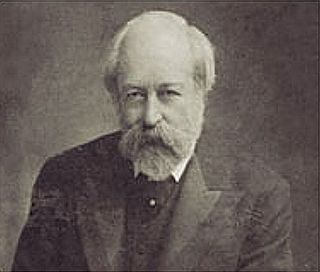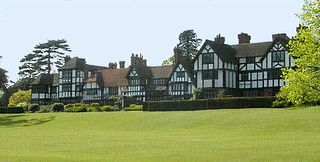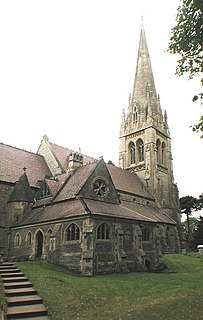
The Jacobethan or Jacobean Revival architectural style is the mixed national Renaissance revival style that was made popular in England from the late 1820s, which derived most of its inspiration and its repertory from the English Renaissance (1550–1625), with elements of Elizabethan and Jacobean.

Vorticism was a London-based modernist art movement formed in 1914 by the writer and artist Wyndham Lewis. The movement was partially inspired by Cubism and was introduced to the public by means of the publication of the Vorticist manifesto in Blast magazine. Familiar forms of representational art were rejected in favour of a geometric style that tended towards a hard-edged abstraction. Lewis proved unable to harness the talents of his disparate group of avant-garde artists; however, for a brief period Vorticism proved to be an exciting intervention and an artistic riposte to Marinetti's Futurism and the post-impressionism of Roger Fry's Omega Workshops.

Sir Nikolaus Bernhard Leon Pevsner was a German-British art historian and architectural historian best known for his monumental 46-volume series of county-by-county guides, The Buildings of England (1951–74).
The year 1930 in architecture involved some significant events.

George Frederick Bodley was an English Gothic Revival architect. He was a pupil of Sir George Gilbert Scott, and worked in partnership with Thomas Garner for much of his career. He was one of the founders of Watts & Co.
Jonathan Glancey, is an architectural critic and writer who was the architecture and design editor at The Guardian, a position he held from 1997 to February 2012. He previously held the same post at The Independent. He also has been involved with the architecture magazines Building Design, Architectural Review, The Architect and Blueprint. He is an honorary fellow of the Royal Institute of British Architects, RIBA.
Samuel Sanders Teulon was an English Gothic Revival architect, noted for his use of polychrome brickwork and the complex planning of his buildings.

Tudor Revival architecture first manifested itself in domestic architecture in the United Kingdom in the latter half of the 19th century. Based on revival of aspects that were perceived as Tudor architecture, in reality it usually took the style of English vernacular architecture of the Middle Ages that had survived into the Tudor period. The style later became an influence elsewhere, especially the British colonies. For example, in New Zealand, the architect Francis Petre adapted the style for the local climate. In Singapore, then a British colony, architects such as R. A. J. Bidwell pioneered what became known as the Black and White House. The earliest examples of the style originate with the works of such eminent architects as Norman Shaw and George Devey, in what at the time was considered Neo-Tudor design.

The Architectural Review is a monthly international architectural magazine. It has been published in London since 1896. Its articles cover the built environment – which includes landscape, building design, interior design and urbanism – as well as theory of these subjects.
Ian Douglas Nairn was a British architectural critic who coined the word "Subtopia" to indicate drab suburbs that look identical through unimaginative town-planning. He published two strongly personalised critiques of London and Paris, and collaborated with Sir Nikolaus Pevsner, who considered his reports to be too subjective, but acknowledged him as the better writer.

George Somers Clarke (1841–1926) was an architect and English Egyptologist who worked at a number of sites throughout Egypt, notably in El Kab, where he built a house. He was born in Brighton.

Henry Woodyer (1816–1896) was an English architect, a pupil of William Butterfield and a disciple of A. W. N. Pugin and the Ecclesiologists.

Vers une architecture, recently translated into English as Toward an Architecture but commonly known as Towards a New Architecture after the 1927 translation by Frederick Etchells, is a collection of essays written by Le Corbusier, advocating for and exploring the concept of modern architecture. The book has had a lasting effect on the architectural profession, serving as the manifesto for a generation of architects, a subject of hatred for others, and unquestionably an important work of architectural theory. The architectural historian Reyner Banham wrote that its influence was "beyond that of any other architectural work published in this [20th] century to date", and that unparalleled influence has continued, unabated, into the 21st century.

John Chessell Buckler was a British architect, the eldest son of the architect John Buckler. J. C. Buckler initially worked with his father before taking over his practice. His work included restorations of country houses and at the University of Oxford.

Cuthbert Hamilton (1885–1959) was a British artist associated with the Vorticist movement and later with Group X. He was one of the pioneers of abstract art in Britain.
Joseph Clarke was a British Gothic Revival architect who practised in London, England.

John Billing, FRIBA was an English architect from Reading, Berkshire. His grandfather Richard Billing, father Richard Billing (1784–1853), brothers Richard (1814–84) and Arthur (1824–96) and nephew Arthur Ernest were also architects.
Bridget Cherry OBE, FSA, Hon. FRIBA is a British architectural historian who was series editor of the Pevsner Architectural Guides from 1971 until 2002. She is the co-author of several Pevsner guides.

Hester Margaret Sainsbury (1890-1967) was a British artist, dancer, poet and illustrator.

The Vorticists at the Restaurant de la Tour Eiffel, Spring 1915 is a 1961–1962 painting by the English artist William Roberts. It depicts the Vorticist group gathered at a French restaurant in London.















